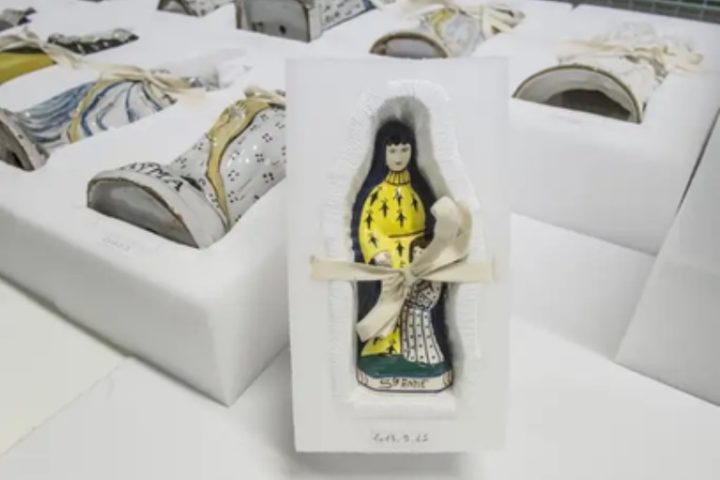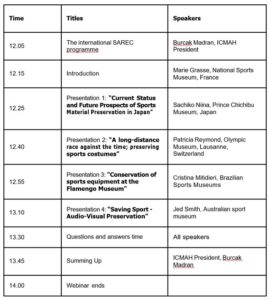October 19, 2025
Equipment Conservation Webinar – October 21st 2025 Session Conference

Equipment Conservation Webinar
The equipment conservation webinar will take on October 21st from 12.00 h to 14.00 h (Paris Time)
Zoom link :
https://us06web.zoom.us/j/82650370241pwd=MbhPFLA1BB8M04MXw6cVJLHMae90qM.1
Marie Grasse, National Sports Museum, France
Introduction
The notion of cultural heritage varies significantly from one country to another, as it is rooted in the historical, legal, and symbolic traditions unique to each society. Some states favor a material conception of heritage, focused on the protection of monuments, works of art, or archaeological sites, while others more readily embrace intangible dimensions such as traditional skills, rituals, or oral expressions. These conceptual differences directly influence conservation policies: they determine priorities for intervention, modes of funding, and strategies for valorization. Moreover, scientific and technical approaches to conservation differ according to laboratories, available resources, and the degree of integration of new technologies. Some centers are equipped with cutting-edge tools enabling non-invasive material analysis, 3D modeling, or digital restoration, whereas others rely more on traditional methods and the transmission of artisanal know-how. Thus, the conservation of cultural heritage, far from being uniform, reflects the diversity of cultural, economic, and technological contexts around the world.
This is what we will be discussing during this webinar.
AGENDA

Sachiko Niina, Prince Chichibu Museum
“Current Status and Future Prospects of Sports Material Preservation in Japan”
This presentation reports on the current state and future outlook of sports material preservation in Japan. The Prince Chichibu Memorial Sport Museum, the nation’s only comprehensive sports museum, is exploring a broader network of institutions. In 2021, an online workshop gathered sports museums, manufacturers, and conservation experts to discuss preservation challenges. Experts noted the short lifespan of sports materials, while museums cited limited resources to address preservation needs. To move forward, collaboration beyond the sports field is essential. Local history museums often hold athlete-related items, and working with their conservators is a realistic approach. Building a network that includes sports manufacturers for preservation advice is also promising. These efforts aim to improve preservation strategies and strengthen institutional cooperation.
Patricia Reymond, Olympic Museum, Lausanne, Switzerland
A long-distance race against the time; preserving sports costumes
The Olympic Museum in Lausanne, Switzerland preserves a large collection of clothes and accessories used in Olympic sports competitions or during the protocolary events. There are the sport outfits and Olympic kits adorned by national delegations, the uniforms worn by the volunteers and staff, and the stage costumes used by performers during the ceremonies. The collection includes about 5900 items worn in competition and 6900 used in a non- competitive context. It is completed by a collection of about 1000 flags and pennants.
Sport costumes present a special challenge to conservators because their tear and wear are
part of the key component in the stories they tell. They are often soiled, torn, damaged, modified or autographed, which make the conservation work more complex. The presentation will describe various conservation challenges encountered by the Olympic Museum. Through selected case studies, it will discuss the role of documentation in conservation-restoration. It will also introduce the oxygen-free storage system recently implemented for preserving certain deteriorating objects.
Cristina Mitidieri
“ Conservation of sports equipment at the Flamengo Museum ”
The presentation addresses the challenges encountered and the strategies implemented by Flamengo’s Historical Heritage Department team in preserving the material assets that constitute the club’s collection – part of which is exhibited at the Flamengo Museum (Rio de Janeiro, Brazil).
Drawing on an overview of the collection – comprising more than 35,000 items – the presentation examines the practical issues involved in its day-to-day conservation, thereby underscoring the relevance of applying museological knowledge to the safeguarding of a heritage of both national and international significance.
Jed Smith, Australian sport museum
Saving Sport – Audio-Visual Preservation
The Australian Sports Museum is halfway through a three-year project to audit and selectively digitise its audio-visual holdings; some 40,000 items. The work is being undertaken now as a matter of urgency as the window closes on our capacity to utilise digitisation suppliers who have access to machines that can play the numerous old formats (tape, film, etc.). In total we have content on some 35 different formats, all of which have their own challenges. My presentation will provide an overview of a challenging project and provide advice and learnings for anyone looking to preserve their own audio-visual sporting heritage.